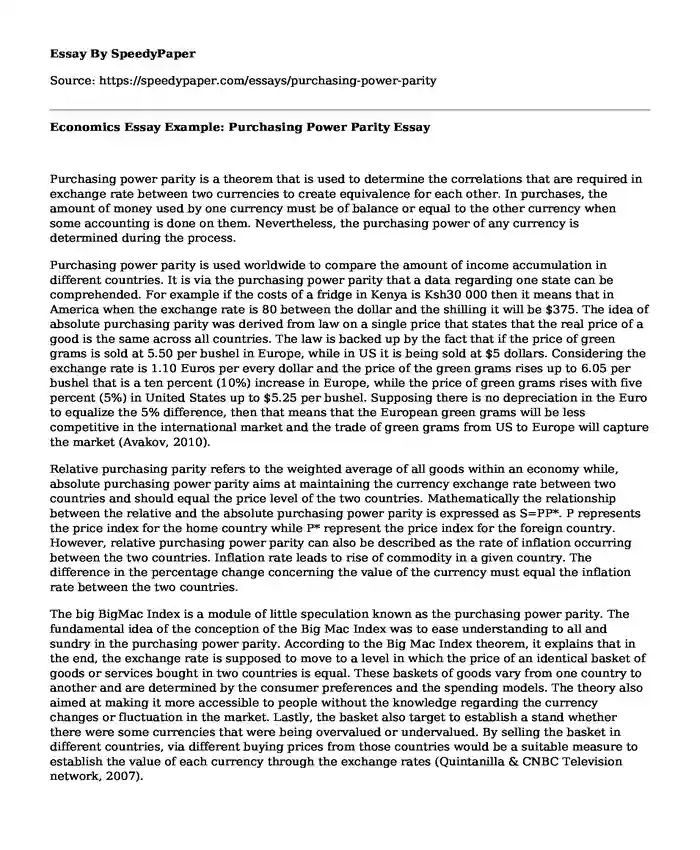Purchasing power parity is a theorem that is used to determine the correlations that are required in exchange rate between two currencies to create equivalence for each other. In purchases, the amount of money used by one currency must be of balance or equal to the other currency when some accounting is done on them. Nevertheless, the purchasing power of any currency is determined during the process.
Purchasing power parity is used worldwide to compare the amount of income accumulation in different countries. It is via the purchasing power parity that a data regarding one state can be comprehended. For example if the costs of a fridge in Kenya is Ksh30 000 then it means that in America when the exchange rate is 80 between the dollar and the shilling it will be $375. The idea of absolute purchasing parity was derived from law on a single price that states that the real price of a good is the same across all countries. The law is backed up by the fact that if the price of green grams is sold at 5.50 per bushel in Europe, while in US it is being sold at $5 dollars. Considering the exchange rate is 1.10 Euros per every dollar and the price of the green grams rises up to 6.05 per bushel that is a ten percent (10%) increase in Europe, while the price of green grams rises with five percent (5%) in United States up to $5.25 per bushel. Supposing there is no depreciation in the Euro to equalize the 5% difference, then that means that the European green grams will be less competitive in the international market and the trade of green grams from US to Europe will capture the market (Avakov, 2010).
Relative purchasing parity refers to the weighted average of all goods within an economy while, absolute purchasing power parity aims at maintaining the currency exchange rate between two countries and should equal the price level of the two countries. Mathematically the relationship between the relative and the absolute purchasing power parity is expressed as S=PP*. P represents the price index for the home country while P* represent the price index for the foreign country. However, relative purchasing power parity can also be described as the rate of inflation occurring between the two countries. Inflation rate leads to rise of commodity in a given country. The difference in the percentage change concerning the value of the currency must equal the inflation rate between the two countries.
The big BigMac Index is a module of little speculation known as the purchasing power parity. The fundamental idea of the conception of the Big Mac Index was to ease understanding to all and sundry in the purchasing power parity. According to the Big Mac Index theorem, it explains that in the end, the exchange rate is supposed to move to a level in which the price of an identical basket of goods or services bought in two countries is equal. These baskets of goods vary from one country to another and are determined by the consumer preferences and the spending models. The theory also aimed at making it more accessible to people without the knowledge regarding the currency changes or fluctuation in the market. Lastly, the basket also target to establish a stand whether there were some currencies that were being overvalued or undervalued. By selling the basket in different countries, via different buying prices from those countries would be a suitable measure to establish the value of each currency through the exchange rates (Quintanilla & CNBC Television network, 2007).
The Big Mac Index has been used for a long time as a measure of exchange rates in different countries. In economics, it is able to predict the value of a currency by explaining the current deviation from which one is able to establish or predict the future purchasing power parity. The idea is based by interpreting and studying the trends in the market rates using the Big Mac index.
A currency that has the closest purchasing power policy is the one that has the capacity to trade with other countries with a high currency value. This is because the country has a bigger buying power or it is capable of making more imports as compared with other countries. The US dollar has the closest purchasing power parity because according to the Big Mac the other are compared to the US dollar to indicate their weighting. The importing power of US is higher as compared to other countries whose currency could be of higher value than the US dollar for example the Sterling pound and the Kuwait Denarius (Parsley, 2003).
References
Attention Required! | CloudFlare. (n.d.). Retrieved from http://www.vectorgrader.com/indicators/purchasing-power-parity
Avakov, A. V. (2010). Two thousand years of economic statistics: World population, GDP and PPP. New York: Algora Pub.
Parsley, D. C., Wei, S.-J, & National Bureau of Economic Research. (2003). A prism into the PPP puzzles: The micro-foundations of Big Mac real exchange rates. Cambridge, MA: National Bureau of Economic Research.
Quintanilla, C., & CNBC (Television network). (2007). Big Mac: Inside the McDonald's empire. United States: CNBC, Inc.
Cite this page
Economics Essay Example: Purchasing Power Parity. (2019, May 15). Retrieved from https://speedypaper.com/essays/purchasing-power-parity
Request Removal
If you are the original author of this essay and no longer wish to have it published on the SpeedyPaper website, please click below to request its removal:
- Free Essay on Steps to Solving a Problem
- Free Essay Example on the Prudhoe Bay Oil Spill
- Essay Example on Food Stamp Fraud
- Free Essay Describing Information Technology Systems of Coca-Cola
- Euthanasia and Ethics, Free Essay for Everyone
- Free Essay: Summary of the Development of the Behavioral Matrix
- Free Essay Example on Hot Spots Policing
Popular categories





